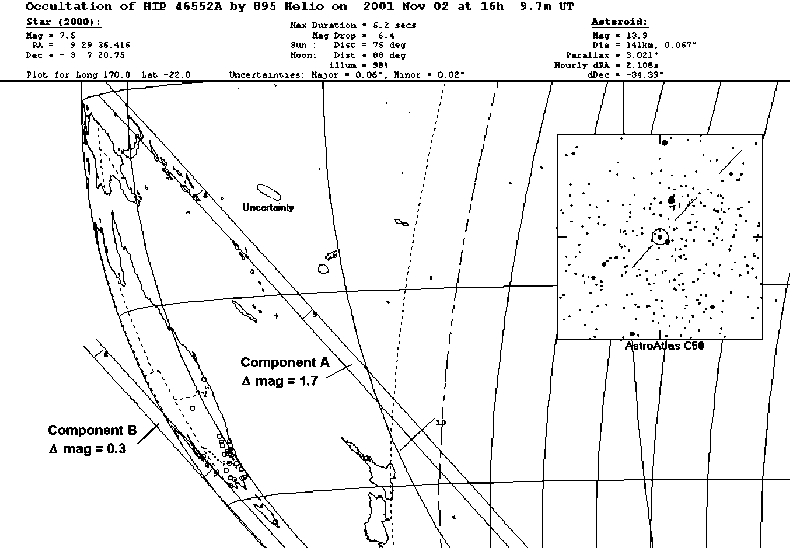THE UPDATED PATH

The target star for this event is a close double - Burnham (beta) 591. As a result there are two paths illustrated on the update above. With a seperation of less than 1.0", it is unlikely that observers will be able to monitor each event seperately and so the magnitude falls illustrated are for the combined system. As such, for visual observers, the primary path is the only one of interest. The primary path lies around one path width to the northeast and around 10 seconds earlier than that given by Occult. After crossing New Ireland, The Solomon Islands and Vanuatu, it misses the North Island of New Zealand around 16:10 UT around the start of local twilight. (The webmaster apologises for the quality of the above graphic)
The error band of this calculation barely reaches the East Cape region though the reliability of the star position is probably poorer than most due to the star's duplicity.
The secondary path with its very low (0.3) magnitude fall crosses southern South Australia at very low altitude around 16:09 UT. Observations made with video/photometric methods would be very difficult due to the amount of airmass the observation would need to be done through.
Calculation Source
This prediction update has been computed by Steve Preston of Medina, Washington (state) in the United States based on astrometry from Ron Stone of the US Naval Observatory - Flagstaff Station, USA supplemented with data from the AstDys database. The Hipparcos position of the target star has been used.
Additional details of this and other events are available at Steve Preston's website at http://www.oz.net/~stevepr/Asteroids/asteroid.htmEVENT DETAILS SUMMARY:
IMPORTANT NOTE!
Astrometric updates such as these should not be taken as definitive, but rather only as an indication of where the true track may lie relative to the original predicted track. Observers must bear in mind that later astrometry, in which the target star is measured in the same field as the asteroid, may still reveal substantial changes to the predicted track and time of the event. For this reason it is most important that observers far from the predicted track still monitor the event.
Use these links for further information:
[Planetary Occultations]
[Using the Predictions]
[Observing Details]
[Timing Details]
[Reporting Details]
[Report Form]
[Asteroid Occultation Results]
[Top of Page][Return to Home Page]